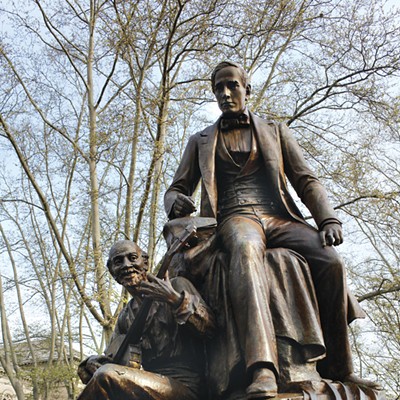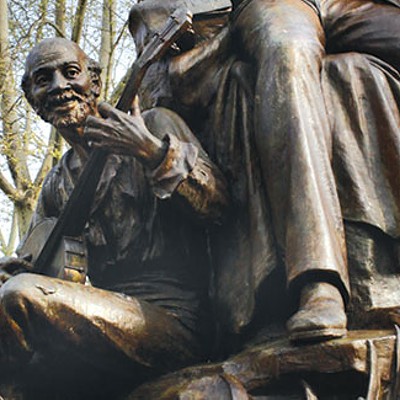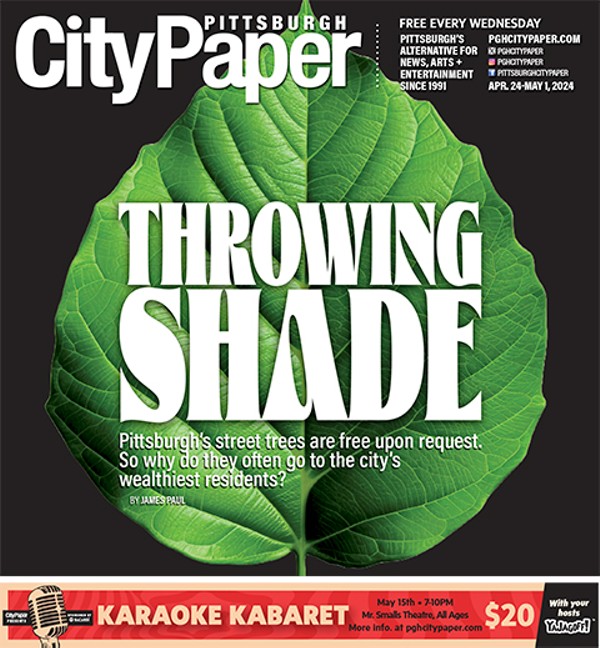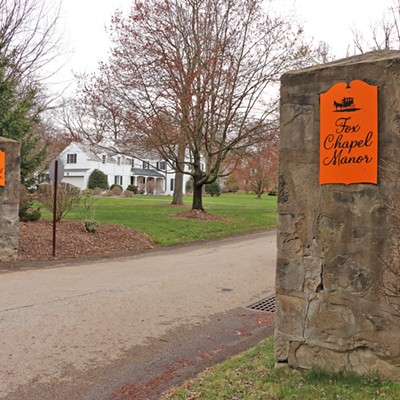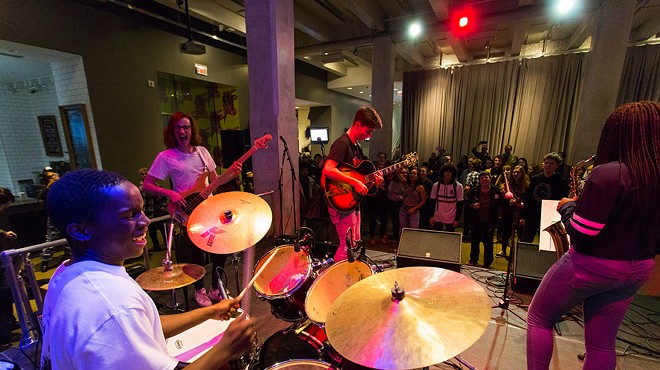Thursday, October 26, 2017
Art commission votes to remove Stephen Foster statue
That troublesome Stephen Foster statue, it seems, is coming down.
Capping decades of racially charged controversy over the 117-year-old bronze memorial to the famed songwriter, the city's Art Commission voted unanimously to remove it from public view and seek a new home where its 19th-century stylings might be given some context.
After taking final comments on the statue's fate from the public, the seven art commissioners deliberated for only about 20 minutes before voting to remove it within the next six months. In the meantime, the city will assemble a report on the costs of removing the statue and the prospects for finding its new home. The commission voted to find a taker for the statue within a year after its removal.
Mayor Bill Peduto will review the commission's findings, but in matters of public art the mayor's office typically defers to commission decisions.
Some commissioners yesterday expressed bluntly their feelings about the statue, which sits on Forbes Avenue outside the Carnegie Museum of Natural History, and depicts the Pittsburgh-born Foster standing, pencil in hand, over a barefoot black man playing a banjo.
"I think it's a really racist statue," said commissioner Sarika Goulatia.
"Having it in public view is sending the wrong message to people living in Pittsburgh and people visiting," said commissioner Kilolo Luckett.
"Public art and sculpture should reflect who we are as a society ... and who we aspire to be," added commissioner Andrew Ross.
Commissioner Kary Mercer-Arimoto noted that the city charter says that public art should be "welcoming in nature." This statue, however, "is fairly divisive."
That is probably an understatement. The statue has been criticized as racist for decades, and was the subject of previous reviews by city government. The latest effort to remove it arose in the wake of the protests over Confederate statuary in Charlottesville, Va., and the murder of a counter-protester there.
An Oct. 4 art-commission hearing included public comment from about two dozen speakers, most of whom advocated removing the statue from public view. (About half the written comments received by the commission also favored removing or relocating the statue.) Among those Oct. 4 speakers was Brittany Felder, who also attended yesterday's session and was pleased by the unanimity of the vote.
"I'm really excited about it," said Felder, a recent graduate of the University of Pittsburgh School of Law who at yesterday's session reiterated to the commission her desire to see the statue removed.
Not everyone was so pleased. James Wudarczyk, of Bloomfield-Lawrenceville, called the vote to remove the statue "a gross miscarriage of justice." Wudarczyk, who also addressed the commission Oct. 4 and again yesterday, cited informal surveys by local media outlets that had indicated overwhelming support to keep the monument where it is.
Wudarczyk and other supporters of the statue argue that Foster himself was not a racist and that the statue was meant to honor the African-American music that inspired him.
But Felder said that the issue is not Foster's own legacy, but imagery that demeans black people.
As of yesterday, said Yesica Guerra, the city's manager of public art and civic design, no takers for the statue had stepped forward. She said that once the statue is removed it might have to go into storage until a new location is found.
Capping decades of racially charged controversy over the 117-year-old bronze memorial to the famed songwriter, the city's Art Commission voted unanimously to remove it from public view and seek a new home where its 19th-century stylings might be given some context.
After taking final comments on the statue's fate from the public, the seven art commissioners deliberated for only about 20 minutes before voting to remove it within the next six months. In the meantime, the city will assemble a report on the costs of removing the statue and the prospects for finding its new home. The commission voted to find a taker for the statue within a year after its removal.
Mayor Bill Peduto will review the commission's findings, but in matters of public art the mayor's office typically defers to commission decisions.
Some commissioners yesterday expressed bluntly their feelings about the statue, which sits on Forbes Avenue outside the Carnegie Museum of Natural History, and depicts the Pittsburgh-born Foster standing, pencil in hand, over a barefoot black man playing a banjo.
"I think it's a really racist statue," said commissioner Sarika Goulatia.
"Having it in public view is sending the wrong message to people living in Pittsburgh and people visiting," said commissioner Kilolo Luckett.
"Public art and sculpture should reflect who we are as a society ... and who we aspire to be," added commissioner Andrew Ross.
Commissioner Kary Mercer-Arimoto noted that the city charter says that public art should be "welcoming in nature." This statue, however, "is fairly divisive."
That is probably an understatement. The statue has been criticized as racist for decades, and was the subject of previous reviews by city government. The latest effort to remove it arose in the wake of the protests over Confederate statuary in Charlottesville, Va., and the murder of a counter-protester there.
An Oct. 4 art-commission hearing included public comment from about two dozen speakers, most of whom advocated removing the statue from public view. (About half the written comments received by the commission also favored removing or relocating the statue.) Among those Oct. 4 speakers was Brittany Felder, who also attended yesterday's session and was pleased by the unanimity of the vote.
"I'm really excited about it," said Felder, a recent graduate of the University of Pittsburgh School of Law who at yesterday's session reiterated to the commission her desire to see the statue removed.
Not everyone was so pleased. James Wudarczyk, of Bloomfield-Lawrenceville, called the vote to remove the statue "a gross miscarriage of justice." Wudarczyk, who also addressed the commission Oct. 4 and again yesterday, cited informal surveys by local media outlets that had indicated overwhelming support to keep the monument where it is.
Wudarczyk and other supporters of the statue argue that Foster himself was not a racist and that the statue was meant to honor the African-American music that inspired him.
But Felder said that the issue is not Foster's own legacy, but imagery that demeans black people.
As of yesterday, said Yesica Guerra, the city's manager of public art and civic design, no takers for the statue had stepped forward. She said that once the statue is removed it might have to go into storage until a new location is found.
Tags: Stephen Foster statue , Pittsburgh Art Commission , Image







